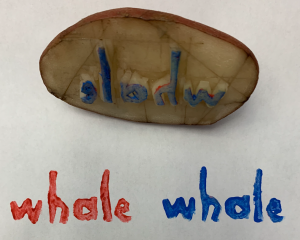For the Potato Print activity, I chose to print the word “whale” using a potato stamp.

Was there something particularly challenging in the process?
The most challenging thing about creating the potato stamp was trying to mirror the image that needed to be etched into the potato. It was very difficult to visualize the letters due to being so used to the letter symbols that we use on a daily basis.
An additional challenge that I had was creating uniformity across the letters, for example, maintaining similar heights and widths across letters. When creating the “e”, I mistakenly removed too much of the potato to allow for the shape I had planned. That left me with the choice to either restart or leave an imperfection.
How much time did it take for you to create the stamps?
It took me approximately ten minutes to plan out my stamp and then an additional thirty minutes to create the stamp. The printing process itself took about two minutes.
Have you noticed anything particular about the letters that you have chosen to reproduce?
I noticed that the printed letters were significantly different than my regular handwriting. I hypothesize that it is the result of the mechanization of the stamp template being difficult to create due to the mirrored letter symbols. It removed some of the personalization of the mechanization of the writing. The printing of the stamps further differentiated the printed letters from my typical written output.
An additional particularity that I noticed was the difference between the prints of the word. The shape and clarity of the word changed depending on how the ink was applied.
Considering the time and effort that took you to create a 5-letter word, how do you feel about the mechanization of writing?
After this activity, I have a greater appreciation for pre-industrial writing endeavors. This process was very time-consuming and would require specialized skills to perfect, as opposed to the very mechanized manner of computer and printer writing that I normally utilize. The time obligations of this activity helped to put into context how the industrialization of writing, through inventions such as the printing press, helped to accelerate the mobilization of knowledge and facilitated the development of modern civilization/information sharing. I would also imagine that with writing/printing being such a laborious process, the importance of the printed word would be greater historically than in a modern society where anyone can easily and quickly create written language.
Additionally, after completing this activity, I found it fascinating to consider that the mechanization of writing has evolved past printing entirely and texts can now exist in a purely virtual context, such as writing in this blog.
I never thought of writing the whole word on one potato. That was genius of you! You only had to waste one potato where as I used five small potatoes and cut them in half. It must have been challenging to carve out the entire word mirrored. Did you end up having to start all over with any errors that you made? Or did you just cut the potato down and try to save it?
If I did an entire word on one potato, I would have had a difficult time making them all uniform. When you noticed that some were uneven, did you notice after stamping it with paint, or just by looking at the potato before printing?
Hi Stephanie,
I actually wrote my word out on a piece of paper with a Sharpie and then pressed the potato onto the ink before it dried in order to create the mirrored word, then I started to imprint the text. This allowed me to avoid really making any errors, in addition to having access to wood carving tools that allowed me to be very precise beyond just using a kitchen knife.
The shape of the stamp looked relatively uniform to the eye, it was only upon the application of the paint and the resulting stamp that was when I noticed the unevenness. This really helped me understand the essence of font and how the imperfections in the stamped word shaped the stylized text that we understand in the computer-processed text today.
Thanks for your response!